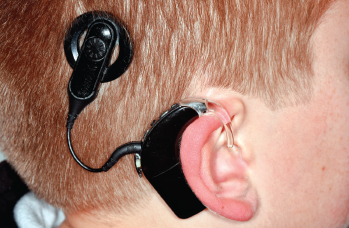
© DR P. MARAZZI / Science Source
Congenital hearing loss is fairly prevalent and can be devastating for patients and their families. Not only can this condition impede a child’s educational attainment, but it can also affect his or her future employment, income, and overall quality of life.
Explore This Issue
June 2019A session on this topic at the Triological Society Annual Meeting was moderated by John Bent, MD, director of the pediatric otolaryngology division and otolaryngology residency program director at Montefiore Medical Center and professor of both otolaryngology–head and neck surgery and pediatrics at Albert Einstein College of Medicine in in Bronx, NY. The panel of experts, through a series of case reports, examined best practices for neonates identified with severe/profound bilateral sensorineural hearing loss (SNHL). Within congenital hearing loss, the panel also looked at cytomegalovirus (CMV), genetics, unilateral moderate hearing loss, unilateral versus bilateral cochlear implants, and cochlear implants for single-sided deafness.
Case 1: Failed Newborn Hearing Screening
Case one is a full-term, non-syndromic, otherwise healthy newborn who has failed the newborn hearing screen.
Matthew L. Bush, MD, PhD, vice chair for research and associate professor in the department of otolaryngology–head and neck surgery at the University of Kentucky in Lexington, said, “This child is facing a ticking clock and the timing of treatment is critical. In a full-term newborn who fails a newborn hearing screening test, we need to repeat testing within the first month after birth.” Some birthing hospitals perform repeat screening testing during the birth admission of infants who fail their screening test to decrease the false positive screening results. Screening and follow-up testing is sometimes delayed in premature infants; however, Dr. Bush advocated for early screening and then follow-up testing to be completed as soon as feasible.
Some evidence shows that if hospitals are involved in scheduling outpatient audiologic follow-up, there is a higher rate of compliance and potentially a shorter time before diagnosis, he added. This requires partnerships between hospitals and audiology and otolaryngology practices.
“Timely diagnosis and treatment of hearing loss is the key in young children, and we should advocate for our healthcare systems to be compliant with the national Early Hearing Detection and Intervention (EHDI) recommendations of meeting the ‘1/3/6’ goals—all infants screened no later than one month, all infants who fail screening have a definitive diagnosis no later than three months, and then intervention occurs by six months,” he said (See “National Early Hearing Detection and Intervention 1-3-6 Goals,”).
“We need to become leaders in early hearing detection and intervention in order to bridge socioeconomic disparities in healthcare delivery amongst children in need of cochlear implantation (CI).” Unfortunately, Dr. Bush added, there are no EHDI initiatives involved in CI. For the child in this case, the first diagnostic test outside the hospital should be as soon as possible, he said. If a child is premature, then he or she may need to reach full term before diagnostic testing. Hearing aids are needed by three months, but as soon as possible is the ideal. If there is profound hearing loss, then rapid implantation is necessary.
“Given that our patients are from diverse backgrounds and regions, delivery of timely, equitable, and appropriate treatment takes leadership on the part of the physician,” he said. “We can partner with our state EHDI programs to provide culturally
appropriate low-tech solutions to support families. Our work from 2018 demonstrated that a parent support program, such as patient navigation, can improve adherence to 1/3/6 EHDI guidelines (Laryngoscope. 2017;127:S1-S13). This can involve enlisting the families of children who have gone through the EHDI process to help other families immediately after the screening testing. Support programs such as this can be truly valuable.”
With regard to imaging, Dr. Bush said that MRI is a suitable tool for the evaluation of most pediatric CI candidates, and a CT scan would work if it’s hard to schedule an MRI.
The decision on how to treat a newborn who fails a screening test depends on money and philosophy, said Blake C. Papsin, MD, MSc, current president of the American Society of Pediatric Otolaryngology and professor of otolaryngology at the University of Toronto in Ontario, Canada. “The science is sound,” he added. “The earlier you can restore the bilateral state, the better it is for the developmental trajectory. If you implant appropriately and have the money and skills, then you can get the baby on and off the operating table in less than three to five hours with minimal blood loss.”
“We don’t operate on a lot of kids under 1 [year of age], either because there is concern about the accuracy of the diagnosis, or money is an issue, or the parents say ‘no,’” he added. “A real challenge in pediatric implantation is the ability to achieve a solid diagnosis and have the appropriate technical skills.”